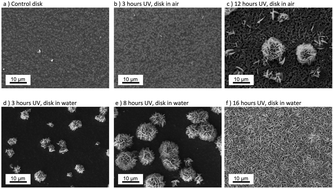Photocatalysis induces bioactivity of an organic polymer based material
Abstract
Several materials, like bioglasses, sintered hydroxyapatite and Ti metals and alloys, have the ability to bond to living bone in vivo, which is a desirable property of biomaterials called bioactivity. In this work, we present a novel strategy to develop bioactivity on the non-bioactive surface of a resin–TiO2 nanocomposite through photocatalysis. The results show that UV irradiation (365 nm, 10 mW cm−2) for 8 to 16 h on the resin–TiO2 nanocomposite immersed in water induces bioactivity as indicated by hydroxyapatite growth following immersion of the samples in Dulbecco's phosphate buffered saline for 7 days at 37 °C. While a non-irradiated resin–TiO2 surface did not show any hydroxyapatite deposition, a surface after 16 h of UV irradiation was fully covered by hydroxyapatite. In vitro cell adhesion of osteoblast-like MG63 cells confirmed the biocompatibility and bioactivity of the resin–TiO2 surfaces with a hydroxyapatite deposition layer, while the non-irradiated resin–TiO2 surface showed no cell adhesion. Resin–TiO2 nanocomposites, with or without UV irradiation, proved to be nontoxic to two human cell lines, human dermal fibroblasts (hDF) and MG63 cells. It was also shown that an increased dose of UV irradiation decreased bacterial adhesion, which is an additional benefit of the UV treatment and a favourable property for biomedical applications. The combined benefits of biocompatibility, bioactivity, decreased bacterial adhesion and the highly efficient disinfection property of TiO2 photocatalysis under UV light make this resin–TiO2 material an interesting candidate for implant and biomedical device applications.


 Please wait while we load your content...
Please wait while we load your content...